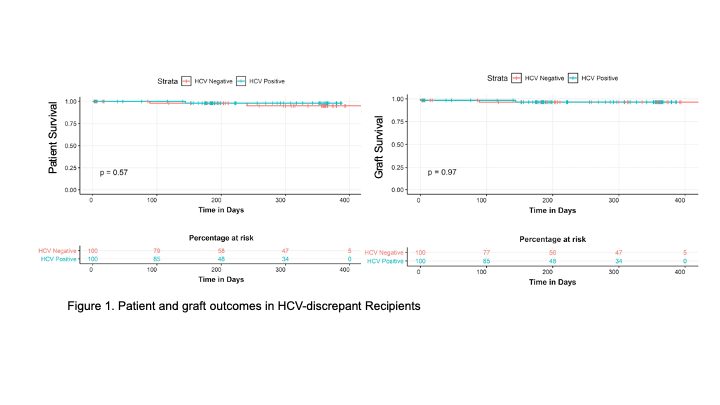Comparison of Outcomes of Hepatitis C Virus (hcv) Nucleic Acid (nat) Positive Donor Between Hcv-naïVe and Hcv + Recpients – A Donor Mate Analysis
University of Virginia, Charlottesville, VA
Meeting: 2021 American Transplant Congress
Abstract number: 400
Keywords: Allocation, Hepatitis C, Kidney transplantation
Topic: Clinical Science » Kidney » Kidney Deceased Donor Allocation
Session Information
Session Name: Kidney Deceased Donor Allocation 1
Session Type: Poster Video Chat
Date: Saturday, June 5, 2021
Session Time: 7:30pm-8:30pm
 Presentation Time: 7:50pm-8:00pm
Presentation Time: 7:50pm-8:00pm
Location: Virtual
*Purpose: Despite a growing mismatch between organ need and supply, organs from HCV+ donors were only offered to HCV+ recipients (HCV R+) to avoid complications of de novo hepatitis. The advent of highly effective direct-acting antivirals, has ushered in a new era where kidneys from HCV+donors can be safely transplanted into HCV naïve recipients (HCV R-). We sought to evaluate the outcomes of the recipients at highest risk of HCV transmission (HCV NAT +/R-) compared to those at lowest risk (HCV NAT+/R+) by conducting a mate kidney analysis of same HCV NAT+ donors.
*Methods: We analyzed data from the Organ Procurement and Transplantation Network database with transplant outcomes up till 12/2019. Sixty-two HCV NAT+ donors donated both kidneys to HCV-discrepant recipients.
*Results: The first eligible donor was identified in 2017. Thereafter, a steep increase occurred in 2018 with 32 such pairs transplanted. Mean donor age was 32 ±7 y, 37% were women, and 4% were of Black race. Majority were donors after brain death (85%) with mean KDPI of 44 and optimized KDPI of 20.Recipients in the 2 groups were similar in most respects, with a mean age of 58 ± 9 y, 74% males, 47% Black and, 15% had prior transplant. Diabetes mellitus (37%) was the most common cause of end-stage kidney disease and 87% were on dialysis prior to transplant. While the dialysis vintage time was similar in both groups (2.7 y), the time of listing to transplant was shorter in the HCV R+ cohort (42 vs 604 d, p<0.001), reflecting the possible update of acceptance criteria of the HCV R- in order to avail of HCV NAT + donors. The relatively short cold ischemia time (17 hours) and the low rates of delayed graft function (4.9%) is indicative of very selective HCV NAT + donors being considered for kidney donation. Median follow-up was 216 days with similar outcomes (graft and patient survival) in both groups (Figure 1). R HCV status did not correlate with patient or graft survival.
*Conclusions: Recipients who are at higher risk from HCV transmission, achieved an excellent short term patient and graft survival, similar to the HCV R+. While we were unable to analyze HCV treatment information due to the nature of the registry dataset, it is highly probable that successful HCV therapy post-transplant was the equalizing factor. The similar recipients characteristics in both cohorts reflects a uniform approach in picking eligible recipients of HCV + organs, regardless of recipient status. In conclusion, the use of HCV NAT + kidneys in HCV naive recipients appears to be a safe and should be promoted.
To cite this abstract in AMA style:
Kamal J, Sharma B, Doyle A, Kumar A, Nishio-Lucar A, Rao S. Comparison of Outcomes of Hepatitis C Virus (hcv) Nucleic Acid (nat) Positive Donor Between Hcv-naïVe and Hcv + Recpients – A Donor Mate Analysis [abstract]. Am J Transplant. 2021; 21 (suppl 3). https://atcmeetingabstracts.com/abstract/comparison-of-outcomes-of-hepatitis-c-virus-hcv-nucleic-acid-nat-positive-donor-between-hcv-naive-and-hcv-recpients-a-donor-mate-analysis/. Accessed December 26, 2025.« Back to 2021 American Transplant Congress

